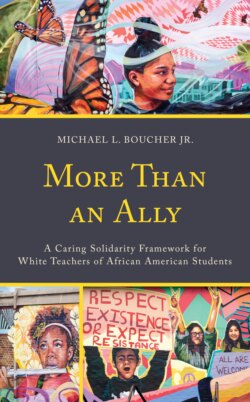Читать книгу More Than an Ally - Michael L. Boucher Jr. - Страница 19
На сайте Литреса книга снята с продажи.
Centering Race, Not Talking about Race, Offense, and Avoidance
ОглавлениеMcIntosh (2001) observed that there are unearned privileges given to Whites based on the fact that they are White people in a country where whiteness is normalized. James Baldwin clarified that whiteness is an illusion (Coates, 2015). Allen and Liou (2018) have explained whiteness as being “rooted in the active pursuit of White racial interests through the creation of institutional norms framed by the White supremacist social structure and its related normalized systems of practices” (p. 679).
Bonilla-Silva (2010) explained that there is a pervasive practice in schools referred to as “color-blind racism” (p. 2). This tendency allows White teachers to blame Black students for their failure, and Black parents can be ignored for not attending to their child’s schooling. Ideological color blindness is a major force in the larger society (DiAngelo, 2018). As Hayes and Juarez (2012) explained, “holding on to a color-blind framework allows people to address only the egregious forms of racism” (p. 7).
The practice of color-blindness allows White people to ignore “the very knowledge of culturally responsive teaching and social justice that is needed to transform the whiteness of education” (Hayes & Juarez, 2012, p. 7). In multicultural classrooms, centering race and culture is an exercise in freedom for both teacher and students. If race and culture are not out in the open but are left unsaid, secret, taboo, and untouchable, the messages conveyed to students reinforce oppression and privilege and devalue students of color (DiAngelo, 2018).
It seems counterintuitive to some White people that talking about race is the best way to combat racism. The avoidance of race talk largely derives from a misunderstanding of race combined with an unwillingness to begin dismantling White supremacy in individuals and structures. Not talking about cancer did not lead to a cure for cancer. Not talking about sexual assault has not led to an end to sexual violence. Not talking about a subject has never solved it.
For example, Arizona has a troubled past and present when it comes to race and culture in the classroom, even taking the unusual step of banning “ethnic studies” courses in 2010. The climate of fear that surrounds schools in many states when talking about race and culture means that when teachers do engage in discussions, they risk infuriating White parents and legislators (Palos & McGinnis, 2012). Yet, when they do not have these conversations, students will act out in ways that reflect their lack of understanding.
In January 2016, the senior class of Desert Vista High School in Ahwatukee, Arizona, near Phoenix made black T-shirts with one gold letter per shirt spelling out “best*you’ve*ever*seen*class*of*2016” in large gold letters. After the picture, six White female students stood together laughing and photographed themselves with their shirts spelling out “ni**er” using the letters and asterisks from the previous photo formation.
The photo went viral on social media and created a storm that enveloped the students and the school. The students were immediately punished with five-day suspensions, and one student gave a public, tearful apology for “offense” while insisting that she was “not racist” (White & Ruelas, 2016).
When these students apologized for their offense, they did not understand that while their actions were indeed offensive, they were offensive because the students were both disrespectful and dismissive of the history of that word and its use as a tool of oppression. They tried to explain that to them it was just a “bad word,” and they were just breaking the rules of decorum, not trying to subjugate their classmates or neighbors. They considered the word to be a vulgarity on the same level as swear or curse words that they could not use in school. They refused to see that this action was different. It was an act of oppression, and the administration reinforced that impression through inaction.
The language around offense places the blame on those who receive the disrespect, not on those who wield words as weapons. In schools and our social discourse, we have dealt with the language and not the reasons for the language. These students argued that their actions were not racist because their White privilege allowed them to avoid seeing that they were not only being offensive but oppressive. These personal actions were not understood by them as racism because to them only bad people are racist, and they did not perceive themselves as bad people. Instead, it was a professed act of rebellion, using a “bad word” they knew was taboo.
In the investigation that followed, the tearful apologies were accepted, and the students returned to school. However, the most important question was not asked by the administration: Against whom was this a rebellion? The rebellion was against the idea that, as White people, there is something that is forbidden for them to say or do.
In the effort to paint racists as bad without dealing with the roots of White supremacy, schools have made oppressive language forbidden fruit that can only be experienced among trusted associates. By avoiding race and the history of colonial oppression from Arizona’s founding, the Arizona school’s approach fed racism and pushed White students toward White supremacy rather than extinguishing it.
White America’s unease and denial about race, the history of race, and White supremacist structures create the ability to be “bad” in safe contexts. These words, when used in these contexts, are supposed to be fun, festive, or risqué. These spaces allow White people to vent their anger at perceived transgressions against White supremacy.Ultimately, by not teaching explicitly about racism, oppression, and race, schools are perpetuating the worst of these things.
